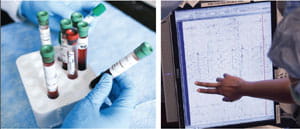Blazing the Regulatory Trail From Mouse to Man
 In October 2014, pulmonologist Bruce Trapnell, MD, MS, and his collaborators published a groundbreaking report in the journal Nature, demonstrating that transplanting normal or gene-corrected macrophages into the lungs of mice with hereditary pulmonary alveolar proteinosis (PAP) was safe and well-tolerated.
In October 2014, pulmonologist Bruce Trapnell, MD, MS, and his collaborators published a groundbreaking report in the journal Nature, demonstrating that transplanting normal or gene-corrected macrophages into the lungs of mice with hereditary pulmonary alveolar proteinosis (PAP) was safe and well-tolerated.
The team showed that a single administration corrected the lung disease and secondary systemic manifestations, normalized disease-related biomarkers, and prevented disease-specific mortality.
This data advanced the future of medicine in which a patient’s own cells will be corrected for their disease-causing mutation, reprogrammed and transplanted back into the patient - thus curing their disease.
Translational team members within the Office for Clinical and Translational Research (OCTR) work alongside the basic scientists and clinicians to move these promising results into human studies and treatments. The office provides sponsors and investigators with comprehensive support services, research tools, personnel and facilities to conduct or facilitate research studies, both pediatric and adult.
 During the Trapnell Lab’s pre-clinical work, for instance, an OCTR team of translational specialists concurrently began the exploration of the regulatory pathway forward to begin a treatment in humans based upon the mouse results. This team includes regulatory specialists with strong scientific backgrounds, FDA and IRB expertise and knowledge of clinical trials.
During the Trapnell Lab’s pre-clinical work, for instance, an OCTR team of translational specialists concurrently began the exploration of the regulatory pathway forward to begin a treatment in humans based upon the mouse results. This team includes regulatory specialists with strong scientific backgrounds, FDA and IRB expertise and knowledge of clinical trials.
As the work progresses toward first-in-human studies, OCTR experts will navigate the trial through the regulatory approval process, with the safety of all study participants as their foremost concern. Working closely with the Trapnell Lab, the center looks forward to the day on which Cincinnati Children’s announces the cure has been found for PAP.



